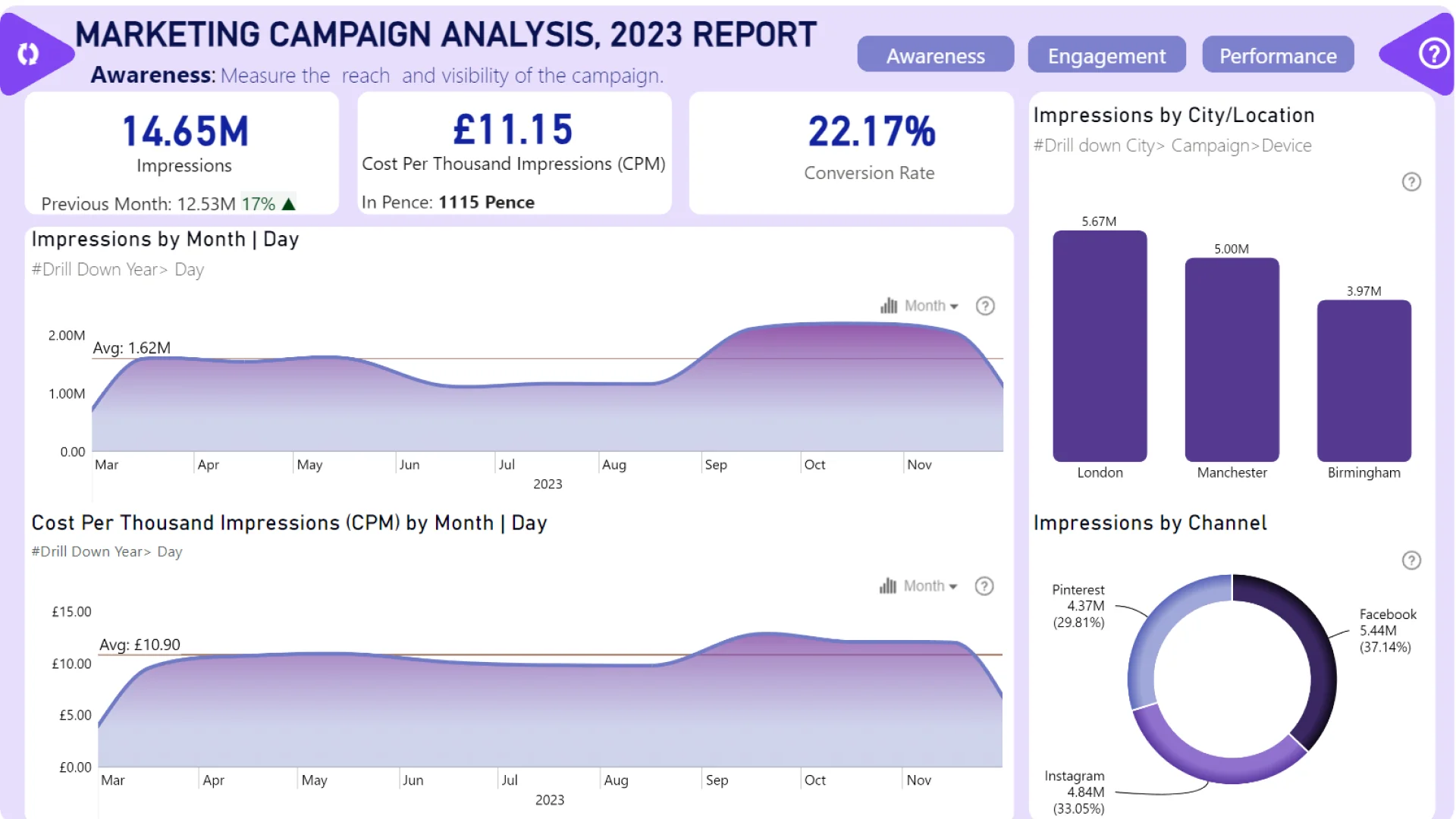Feel free to leave your vote:
10
Share template with others
Summary
Report submitted for OnyxData #DataDNA and ZoomCharts Challenge June 2024. The report was built with the Marketing Campaing Dataset and includes ZoomCharts custom Drill Down PRO visuals for Power BI.
Author's description:
For the marketing campaign analysis, I categorized metrics into three categories: Awareness, Engagement, and Performance.
Awareness: This category aims to measure the reach and visibility of the campaign. Key performance indicators (KPIs) analyzed include impressions, cost-per-thousands (CPM), and conversion rate.
Engagement: This category assesses audience interactions with the ad. KPIs analyzed include likes, shares, comments, clicks, and click-through rate (CTR).
Performance: This category evaluates the overall effectiveness and financial return of the campaign. KPIs analyzed include Cost (Spend GBP), Revenue (Conversion value GBP), Cost-Per-Click (CPC), Profit, Return on Advertising Spend (ROAS), and Return on Investment (ROI).
KEY FINDINGS:
-
Despite its lower budget, the summer campaign achieved the highest ROAS at 1409% and ROI at 1308.9%. Additionally, it reported the lowest CPM.
-
Discount ads had the highest budget allocation and generated the highest revenue of £1,074,061.5, with an ROAS of 1179% and an ROI of 1079.3%. However, collection ads demonstrated the lowest CPM.
-
The Pinterest channel incurred lower advertising costs while generating higher revenue compared to Facebook and Instagram. Pinterest achieved the highest ROAS at 2247% and ROI at 2147.3%, along with the lowest CPM.
-
Birmingham had the lowest advertising costs, yielding substantial revenue of £550,019.1, an ROAS of 1393%, and an ROI of 1293%. Birmingham also reported the lowest CPM.
-
Desktop devices had the highest costs but generated the highest revenue of £949,684.4, with the highest ROAS (1101%) and ROI (1001.5%). Mobile devices performed better in terms of impressions due to lower cost-per-thousand impressions.
RECOMMENDATIONS:
-
Cost Efficiency and Budget Allocation:
- Regularly evaluate and adjust budgets based on campaign performance, focusing on areas with the highest returns.
- Continue to monitor and aim to reduce CPM across all campaigns to improve ROI.
-
Data-Driven Decision Making:
- Implement a robust tracking system to continuously measure key metrics like ROAS, ROI, and CPM.
- Use A/B testing to refine ad creatives and targeting strategies for optimal performance.
-
Channel Optimization:
- Diversify advertising efforts across multiple channels but allocate more resources to those demonstrating higher ROI.
- Stay updated with trends and best practices for each platform to maintain a competitive advantage.
-
Geographic and Demographic Insights:
- Analyze geographic and demographic data to identify other potential high-performing markets.
- Customize campaigns to the preferences and behaviors of audiences in different regions for better engagement and conversion rates.
By following these recommendations, the marketing team can enhance the effectiveness and profitability of future campaigns, ensuring sustained growth and improved return on marketing investments.
ZoomCharts visuals used
Mobile view allows you to interact with the report. To Download the template please switch to desktop view.
